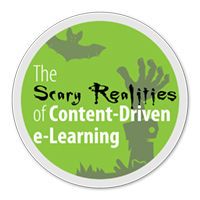Blog
All I Need to Know about Instructional Design I Learned from a Blue Jay
by Ethan Edwards, chief instructional strategist


The Best Content for e-Learning
By Allen Interactions | August 18, 2010 | Custom Learning | 0 Comments

by Ethan Edwards, chief instructional strategist
People often wonder how to choose the best content for e-learning. It would be great if there were an easy formula to apply to provide guidance. Several possible answers that come to mind: “Everything is suitable for e-learning;” “Nothing is suitable for e-learning;” or “There’s no straightforward answer.” And all these answers might be correct.
 First off, you have to first articulate why you are considering applying e-learning in the first place. There are a number of reasons, and the reasons that are driving your organization will likely determine what content should go onto e-learning. I’m going to list of few of these motivators and some of the reasons for and against e-learning. Your actual decision, I think, would rest on how you balance these factors.
First off, you have to first articulate why you are considering applying e-learning in the first place. There are a number of reasons, and the reasons that are driving your organization will likely determine what content should go onto e-learning. I’m going to list of few of these motivators and some of the reasons for and against e-learning. Your actual decision, I think, would rest on how you balance these factors.
Cost Saving
A lot of organizations seek to cut costs by implementing e-learning. But good e-learning (poor e-learning, too, for that matter) can be relatively expensive to develop compared to other forms of training. Any cost savings is going to be realized through the volume of delivery—the cumulative savings in class time, teachers and other instructional resources, classroom real estate, travel, printing expenses, etc. So e-learning makes sense when you have an extraordinarily high number of people to be trained on a topic.
But on the other hand, sometimes the cost of delivery that you are striving to reduce is really is a result of having an extraordinarily LOW number of students for a particular topic. The cost of offering classes and certifying instructors for training that needs to be done for only a few individuals over the course of several years could very well dictate that e-learning makes huge sense then.
Currency of Content
Many people point to the immediacy of e-learning as a great selling point. Instruction can be updated immediately, and learners all around the world have immediate access to latest ideas, without waiting for new materials to be printed and distributed. So this suggests that content that changes frequently is a good target for e-learning.
But on the other hand, unless you are able to invest in sophisticated, data driven interactivity models, e-learning can be extraordinarily difficult and time-consuming to update. If narration and video are involved then another layer of complexity is added, which may suggest that if the content is going to be changing frequently, then it may not be a good target for e-learning.
Knowledge Delivery
When learners have great diversity in background and prior knowledge, you can use e-learning as a leveling device to bring learners to a consistent level so that instructor-led instruction will have an informed pool to address and classroom activities can focus on higher-level skills and applications of the knowledge.
But on the other hand, it is exceptionally difficult to use e-learning effectively if your goal is to dump content on learners and expect it to have some effect. e-Learning requires meaningful activity in the design, and simplistic reading comprehension testing typical of this approach accomplishes very little. In practice, this strategy also fails to take advantage of a primary strength of e-learning: adaptive instruction. Major instructional opportunities are lost when the focus is to tell everybody exactly the same thing, rather than the more useful approach of telling each student exactly what he/she needs.
Skill Building
The individualization of performance that e-learning can provide is ideal for practice and application, so a better strategy, in many ways, is to use e-learning for problem solving and application topics. In a classroom or in any group structure, it is very difficult to provide sufficient practice opportunities and individualized feedback as learners struggle with complex challenges, or even when learning simply requires extensive rehearsal with feedback.
But on the other hand, this kind of e-learning, in general, requires a less dictated approach to design and also flexibility in use of development tools that is out of the reach of some designers or (foolishly, I think) restricted in corporate procedures.
“OK, but you still haven’t given me a clear answer.”
There are plenty of other factors, too, but the interesting thing to note is that only some of them actually have to do with instruction. A lot just have to do with cost/benefit business decisions.
Now I know you’re thinking, “This isn’t helping.” There are simply too many, often contradictory, factors to suggest a simple solution. And as long as tools continue to dictate so much of what actually gets built, we are going to be in a position where too often the real potential is lost due to operational constraints. And sometimes one factor will completely trump another. For example, an ideal training experience might require one-on-one personal consultation; but if 20,000 people need to be trained within two weeks, the right decision very-well might be to create a less-effective online strategy that will at least reach the people (or else decide that the quality of the experience is more important and scrap the idea of putting it on line). No one can make that decision for you, but as the old song goes: “Somethng’s gotta give.”
In a perfect world, I would say that e-learning is most uniquely-effective for teaching skills heavy in internalizing and applying concepts in more open-ended environments that require critical thinking, experimentation, exploration, self-assessment, and individualized feedback. To achieve this, though, requires investment in instructional design, media excellence, and development tools. I would also say that the least effective e-learning I’ve encountered is that which is limited to content delivery with interactivity focused entirely on immediate recall (unless, of course, the goal of the instruction really is strictly one of memorization—like memorizing three-letter city airport codes) and simplistic testing and scoring. But I have seen e-learning lessons across the entire spectrum of learning that you could make the case for being the perfect example of e-learning, given the constraints in time, budget, skills, or technology that needed to be balanced.
.png?width=135&height=135&name=ai-symbol-green%20(3).png)
About the Author: Allen Interactions
Comments
Would you like to leave a comment?
Related Blog Posts

By: Allen Interactions | Jun, 2011
Category: Custom Learning

Blog
Successful e-Learning Content Analysis
by Ethan Edwards, chief instructional strategist
By: Allen Interactions | Nov, 2011
Category:
.jpg?width=316&name=scaryrealities(200).jpg)
Blog
[Upcoming Webinar] The Scary Realities of Content-Driven e-Learning
by Ethan Edwards, chief instructional strategist
By: Allen Interactions | Oct, 2013
Category: Custom Learning
